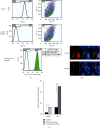The Combination of Zerumbone with 5-Fluorouracil for Sensitizing Colorectal Cancer-Associated Fibroblasts to Treatment
- PMID: 35449812
- PMCID: PMC9017496
- DOI: 10.1155/2022/9369328
The Combination of Zerumbone with 5-Fluorouracil for Sensitizing Colorectal Cancer-Associated Fibroblasts to Treatment
Abstract
The present study aimed to evaluate the synergic effects of combination therapy on 5-fluorouracil (5-FU) resistance-cancer-associated fibroblasts (CAFs) to treatment. Chemotherapy resistance is an important challenge in colorectal cancer (CRC) eradication attention to the tumor microenvironment (TME) is very important. CAFs in the TME play an essential role in cancer chemoresistance and relapse. Additionally, many patients with advanced CRC show resistance to 5-FU therapy. Anti-tumorigenic activities of ZER, a chemopreventive compound derived from the rhizomes of the wild ginger, have been demonstrated. Synergistic and potentiating effects of combination therapy, using herbal and chemical drugs, can improve patients' response. At the first, CAFs were isolated from a CRC patient and sorted by fluorescent-activated cell sorting (FACS), then, confirmed by flow cytometry, and immunocytochemistry (ICC). The effect of 5-FU and ZER on the cell viability was investigated by MTT assay in a dose and time-dependent manner, after that, the expression of vimentin, β-catenin, and survivin was quantified. Apoptosis, cell cycle, and invasion were analyzed by flow cytometry and scratch test, respectively. ZER could significantly sensitize CAFs cells to 5-FU. A combination of 5-FU + ZER revealed a marked decrease in the marker of interest in both mRNA and protein levels compared to control groups, including 5-FU, ZER treated, and untreated cells. Functional evaluation of cells in different groups presented significant suppression in migration of CAFs and an apparent increase in cell arrest and apoptosis by 5-FU + ZER treatment.
Copyright © 2022 Sima Nobari et al.
Conflict of interest statement
The authors declare no conflicts of interest.
Figures







Similar articles
-
Modulation of the tumor microenvironment by zerumbone and 5-fluorouracil in colorectal cancer by target in cancer-associated fibroblasts.Discov Oncol. 2025 Apr 10;16(1):505. doi: 10.1007/s12672-025-02253-4. Discov Oncol. 2025. PMID: 40208502 Free PMC article.
-
CAFs secreted exosomes promote metastasis and chemotherapy resistance by enhancing cell stemness and epithelial-mesenchymal transition in colorectal cancer.Mol Cancer. 2019 May 7;18(1):91. doi: 10.1186/s12943-019-1019-x. Mol Cancer. 2019. PMID: 31064356 Free PMC article.
-
A promising effect of zerumbone with improved anti-tumor-promoting inflammation activity of miR-34a in colorectal cancer cell lines.Mol Biol Rep. 2021 Jan;48(1):203-218. doi: 10.1007/s11033-020-06035-9. Epub 2021 Jan 4. Mol Biol Rep. 2021. PMID: 33398678
-
Promising Effects of Zerumbone on the Regulation of Tumor-promoting Cytokines Induced by TNF-α-activated Fibroblasts.Curr Med Sci. 2020 Dec;40(6):1075-1084. doi: 10.1007/s11596-020-2289-7. Epub 2021 Jan 11. Curr Med Sci. 2020. PMID: 33428135
-
5-fluorouracil and other fluoropyrimidines in colorectal cancer: Past, present and future.Pharmacol Ther. 2020 Feb;206:107447. doi: 10.1016/j.pharmthera.2019.107447. Epub 2019 Nov 19. Pharmacol Ther. 2020. PMID: 31756363 Review.
Cited by
-
Synergistic effects of abietic acid combined with doxorubicin on apoptosis induction in a human colorectal cancer cell line.Sci Rep. 2025 May 8;15(1):16102. doi: 10.1038/s41598-025-99616-2. Sci Rep. 2025. PMID: 40341222 Free PMC article.
-
Modulation of the tumor microenvironment by zerumbone and 5-fluorouracil in colorectal cancer by target in cancer-associated fibroblasts.Discov Oncol. 2025 Apr 10;16(1):505. doi: 10.1007/s12672-025-02253-4. Discov Oncol. 2025. PMID: 40208502 Free PMC article.
References
LinkOut - more resources
Full Text Sources

